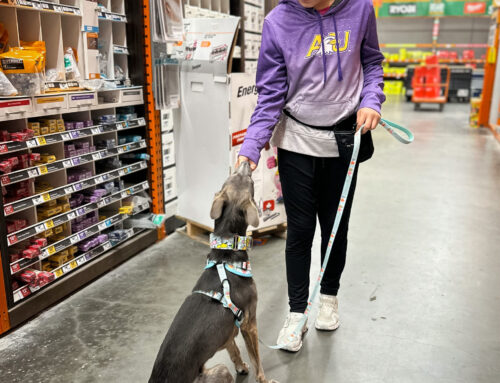Generally speaking, animal-assisted therapy aims to reduce or, in some cases, assist people in coping with certain symptoms of variable circumstances. Depending on the patient’s condition, the dog breed, and the therapy type, the primary function of therapy dogs differs considerably.
It has been scientifically proven that the relationship between therapy dogs and their owners stimulates emotional support, which is good for psychological health! Through their calming presence and companionship gained from working together, therapy dogs have assisted people in overcoming anxiety and depression.
Therapy Dogs
The purpose of therapy animals is to improve health and quality of life. Dogs are the most popular animal used in pet therapy, although birds, cats, guinea pigs, horses, rabbits, and other animals have also been used therapeutically. These amiable, well-behaved animals serve the community through therapeutic interaction by bringing solace, happiness, and fulfillment.
It’s significant to remember that a therapy dog and a service dog are not the same and do not share most of the same rights. For example, a therapy dog can’t enter a place of business with its handler.
How It Works
An animal therapy’s objectives can vary; how well they are achieved will rely entirely on them. The therapy type and target may change depending on the condition and the kind of assistance a person requires. Several instances include:
- Bringing relief and lowering pain intensity
- Enhancing your motor skills
- Developing cognitive, behavioral, and social skills
- Stimulating motivation for pursuits like exercise or social interaction
Owners, or animal handlers, bring their charges to each session as part of the standard protocol for animal therapy. Each handler works under the doctor’s supervision, assisting the person in achieving therapeutic objectives.
Many institutions provide handlers, who are volunteers, with training, and integration with healthcare professionals. Both the animal and the handler must complete various certification processes with these workgroups before receiving approval for use in therapeutic interventions.
Additionally, therapy dogs must pass several inspections, and owners must pass a training session on communicating with people and delivering the various therapies they might offer. These will entail verifying their immunization history and conducting physical examinations, ensuring it’s generally healthy and disease-free.
Ensuring appropriate actions around the handler and other people needs behavioral and emotional screening. Both will also go through obedience training. Access to the best therapy sessions is possible, and the stringent testing and certification process guarantees the competence and security of everyone involved.
A Range of Health Benefits
Therapy dogs may benefit individuals with various conditions and from a wide range of age groups.
Mental Health
Since then, more information about the link between pets and mental health has come to light. Programs that incorporate animals into therapy have consequently grown to be essential parts of mental health care.
Correspondingly, interacting with therapy dogs lowers cortisol, a stress hormone, and enhances the body’s natural stress-reduction chemical oxytocin release. This explains the effectiveness of animal-assisted therapy. Strolling around with a therapy dog also decreases blood pressure due to its sensory act. According to studies, dogs can indeed help calm hyperactive or aggressive kids.
For instance, a pet’s setup and training regime may benefit people diagnosed with ADHD. It may benefit them to manage a therapy dog’s roles and responsibilities in all areas of their lives. This includes tracking the time to feed or walk them at the appropriate times.
Ownership of therapy dogs can be advantageous for people diagnosed with autism. Therapy dogs offer the kind of kindness and compassion that can foster self-confidence and social skills. If their owner is stressed out, they can offer comfort and affirmation.
More importantly, autistic children with sensory impairments can incorporate therapy dogs in sensory integration activities, and it helps them get by how something smells, feels, or sounds.
Enhances Social Connection
Therapy dogs empower socially isolated individuals. Building relationships with peers is simpler for people who own therapy dogs. Additionally, therapy dogs boost emotional growth since they are particularly sensitive to their owners’ emotional states, mimicking human cues. Social interaction has these benefits:
- A higher self-image
- Decreased anxiety and depression rates
- Enhanced happy and upbeat attitude
- Improved emotional control
- Advanced mental capacity
- Unparalleled faith and empathy for other people
Physical Health
Working with therapy dogs may encourage patients to continue therapy, improve their mood, and lessen pain symptoms. It might assist them in moving correctly and frequently exercising for physical conditions. Classifications of physical conditions may also benefit from certain types of therapy dogs, such as:
- Epilepsy
- Diabetes
- Cardiovascular disease
- Post-surgical recovery
- Motor skills development
- Cancer-related pain and discomfort
- Post-stroke recovery
Developing Healthy Habits
Daily maintenance is required for pets, and they consequently assist us in establishing wholesome routines and habits.
- Physical exercise: Dog owners should frequently take their animals on hikes, runs, and walks
- Spending time in nature: Walking a dog gets us outside
- Time regulation: Having a pet is a motivation to start the day by getting up and tending to them
- Self-care: Care of pets is a constant reminder to do the same for oneself.
A Complementary Approach
Therapy dogs should only supplement or enhance other treatments and is not a basic foundation for treating any condition. It does not replace the role and exemplary benefits of other types of therapy, such as physical or occupational therapy and psychotherapy.
Commitment Is Needed
Having a therapy dog requires serious dedication and should not be undertaken on a whim. Therapy dogs are more than just furry friends; they’re also therapy companions. It would help if you had a calm living environment, a consistent routine, resources, time, and energy.
The Unparalleled Work of Therapy Dogs
Dopamine, a chemical crucial to experiencing pleasure, is stimulated in the brain after interacting with therapy dogs. However, not everyone may respond well to this kind of therapy. Depending on the person’s condition, these options will change.
The Alliance Of Therapy Dogs is dedicated to helping certify therapy-dog teams so that they may share this healing connection between humans and pets everywhere. We are here every day working hard, bringing goodness into the world, and doing what we can to extend some grace under pressure when needed. Call us now!






